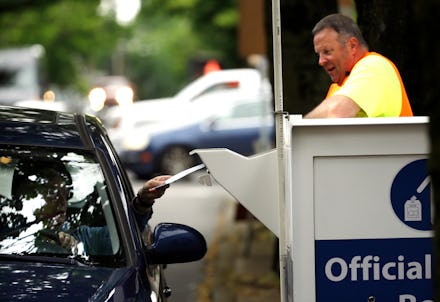One Statistic Shows How Oregon's New Voting System Is Revolutionizing Elections

In 2000, Oregon introduced the nation's first vote-by-mail system, a unique arrangement for casting ballots that has encouraged voter participation across the state. This year, the Beaver State has implemented another unprecedented reform to its voting system: automatic voter registration. So far the data suggests that it's working as policy-makers hoped.
According to a report published by the Center for American Progress on Monday, the new automatic registration system is registering voters at triple the rate of its previous method.
Prior to January, the main way Oregon added new voters to the rolls was when eligible citizens would come into a state DMV office for some kind of issue related to a driver's license. In accordance with a federal 1993 law commonly referred to as the "Motor Voter Act," DMV personnel would offer Oregonians the opportunity to register for voting during their interactions with the agency. While that system facilitated voter registration, it wasn't a wild success — the Oregon DMV was "generating approximately three voter registration applications for every 10 driver licensing transactions under [the National Voter Registration Act]," according to the report.
Read more: Republican Lawmaker Gives Away the Real Reason States Are Instituting Voter ID Laws
At the beginning of this year, Oregon started automatically registering people who visit the DMV to obtain or renew their license. Instead of having DMV personnel ask people questions about opting in during rushed and stressful interactions unrelated to voting, Oregon's Secretary of State office now simply mails eligible individuals a notification that they'll be registered to vote unless they choose to opt-out, which is also done by mail.
The new policy has been effective so far — there were over 1.5 times the number of new voter registrations in the first four months of 2016 than there were in the first four months of 2008, the last time there was a presidential election without an incumbent. So far, only 6% of people who have received notifications about being automatically registered have returned cards declining to be registered.
Automatic voter registration is an example of how institutions can "nudge" individuals toward certain preferred outcomes by making subtle tweaks to how systems are implemented. In the case of voting, it's much easier to ensure that people are registered to vote if you make the process less cumbersome and imply that it's a good thing for citizens to do.
It should be noted, of course, that many people who are being registered automatically in Oregon still won't vote. While registered voters turn out in very high numbers for presidential elections, most of those people have very deliberately chosen to register themselves. An automatic system will inevitably add people to the voter rolls who may have little interest in voting.
However, automatic voter registration may avoid a problem that's kept people from the polls in the past: the report cites research estimating that in the last presidential election, early registration deadlines blocked between 3 and 4 million people from voting.
Oregon has its presidential primary on Tuesday, which should provide the first opportunity to see if the new system gives voter turnout a boost.